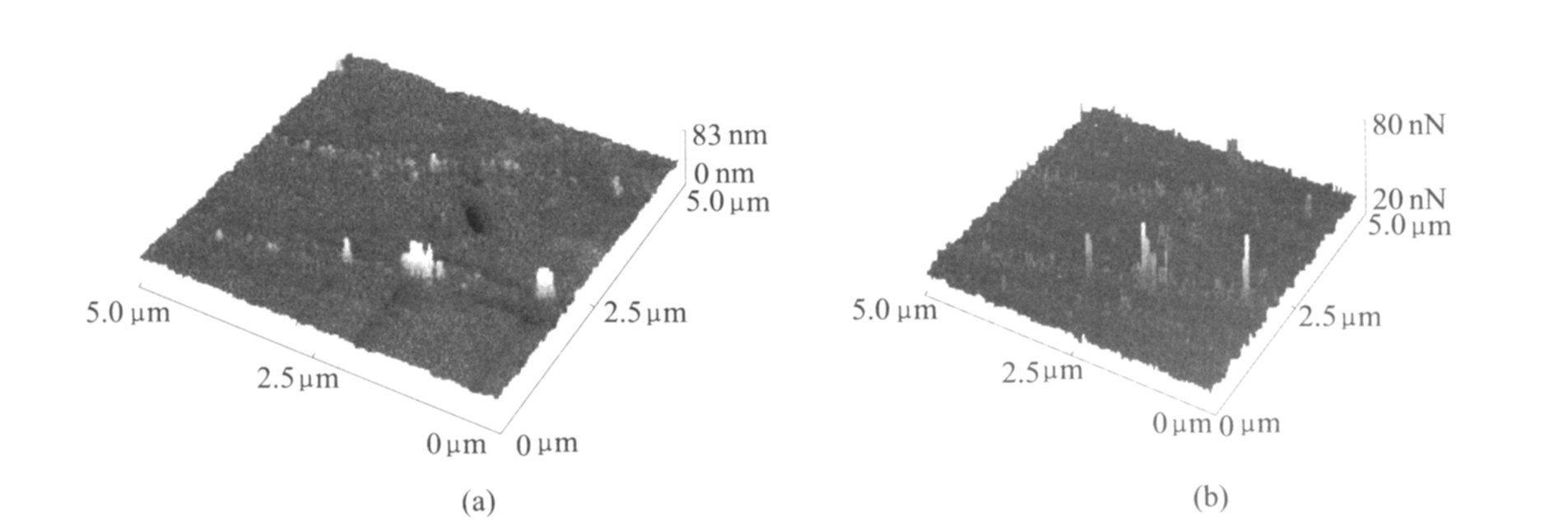中国有色金属学报 2003,(01),136-140 DOI:10.19476/j.ysxb.1004.0609.2003.01.025
碳化硼陶瓷的表面形貌和摩擦性能
五邑大学化学与环境工程系,中南大学粉末冶金国家重点实验室 江门529020 ,长沙410083
摘 要:
用原子力 /摩擦力显微镜对碳化硼样品进行了表面形貌的微观分析。在载荷为 1~ 6 μN下 ,研究了Si3 N4探针扫描碳化硼表面时摩擦力的分布。结果表明 :摩擦力的变化与扫描处的试样表面形貌有关 ,表面形貌变化斜率越大处 ,摩擦力增加得越多 ;由于试样较平整 ,摩擦力的分布是比较均匀的 ;碳化硼材料纳米摩擦因数随载荷的增加而显著增加
关键词:
中图分类号: TQ174.67
作者简介:吴 芳(1971),女,副教授,博士.;
收稿日期:2002-03-24
基金:国家“九五”科技攻关项目 (98-A2 8-11);
Nano tribology properties of boron carbide ceramic studied by atomic force microscope
Abstract:
The topographical characteristics of the boron carbide sa mp le surfaces were investigated with atomic force microscope/friction force micros cope (AFM/FFM). As the results, the samples are of good consolidation and the s urfaces of the polished samples are even. The friction force distributions of Si 3N 4 tip scanning over the boron carbide surfaces were investigated at load 1 μN to 6 μN, 1 μN a step. The results show that friction force changes wit h the surge of surface topography. The steeper slope of surface topography links with the higher friction force. Friction forces are almost uniform at certain n ormal load since the surface is even. The nano tribological friction coefficient of boron carbide increases with the normal load rising.
Keyword:
boron carbide; AFM/FFM; surface topography; nano friction coefficient;
Received: 2002-03-24
碳化硼具有一系列优良的性能: 如密度低, 理论密度仅为2.52×103 kg/m3; 硬度高, 是仅次于金刚石和立方BN的最硬材料; 化学性质稳定, 是化学性质最稳定的化合物之一; 同时碳化硼还具有很好的力学稳定性和很低的热膨胀系数。 基于这些优良的特性, 碳化硼在许多领域得到了广泛的应用
本文作者首次将原子力显微镜、 摩擦力显微镜等先进的纳米摩擦学测试手段用于研究碳化硼材料的纳米摩擦性能, 初步考察了一些主要的变化因素对碳化硼材料纳米摩擦行为的影响。
1实验
1.1试样制备
本实验所用试样为热压碳化硼材料。 热压条件为: 温度2 273~2 473 K; 压力30~40 MPa; 保温保压时间约100 s。 所得碳化硼试样的性能参数如表1所示。 在进行纳米摩擦实验前, 试样经粒度<1 μm的金刚石粉精研至宏观表面粗糙度Ra<0.2 μm, 用蒸馏水反复洗净后, 置于丙酮中用超声波清洗器处理300 s, 再在蒸馏水中煮沸10 min, 取出置于空气中干燥待用。
表1 热压碳化硼材料的基本性能
Table 1 Properties of hot-pressed boron carbide
Density /(kg·m-3) |
Bending strength/MPa |
Knoop hardness/ GPa |
Grain size/μm |
Porosity / % |
2 500~2 510 |
510~520 | 29.5~30.0 | <1 | <0.1 |
1.2实验方法
实验采用Nano-Scope Ⅲ型AFM/FFM原子力/摩擦力显微镜, 该仪器能同时测得表面形貌和摩擦力。 扫描采用Si3N4探针, 其针尖半径约为30 nm。 Si3N4探针的自由端与试样表面接触。 在AFM/FFM测量过程中, 平行于探针运动方向的扫描速率为200 nm/s, 垂直于探针运动方向的扫描速率为2 nm/s。 纳米摩擦测量时的扫描范围为5 μm×5 μm。 测量时扫描范围的选择是随机的。 测量在室温(298 K)下于空气中进行, 空气相对湿度为40 %~50 %。 所用法向载荷(f)分别为1 μN, 2 μN, 3 μN, 4 μN, 5 μN, 6 μN。
2结果和讨论
图1~图6是碳化硼表面形貌和在不同载荷下所得的摩擦力分布的三维图。
2.1试样的表面形貌
由于实验时扫描区域是随机选取的, 图1至图6所测的6处表面形貌分布图可统计地反映试样的表面形貌状况。 由表面形貌分布图可以看出:
1) 试样表面平整。 各扫描区域内, 扫描高度距离基准面高度一致, 最凸处与最凹处相差分别只有94, 83, 60, 141, 45, 80 nm, 且凹凸不平处所占的比例很小。图2、 图5和图6中几道“沟漕”, 可能是磨样过程中留下的。
图1 载荷为1 μN时碳化硼试样的表面形貌和摩擦力分布图
Fig.1 Surface profile and friction force profile for normal load of 1 μN (a)—Surface profile; (b)—Friction force profile
图2 载荷为2 μN时碳化硼试样的表面形貌和摩擦力分布图
Fig.2 Surface profile and friction force profile for normal load of 2 μN (a)—Surface profile; (b)—Friction force profile
图3 载荷为3 μN时碳化硼试样的表面形貌和摩擦力分布图
Fig.3 Surface profile and friction force profile for normal load of 3 μN (a)—Surface profile; (b)—Friction force profile
图4 载荷为4 μN时碳化硼试样的表面形貌和摩擦力分布图
Fig.4 Surface profile and friction force profile for normal load of 4 μN (a)—Surface profile; (b)—Friction force profile
图5 载荷为5 μN时碳化硼试样的表面形貌和摩擦力分布图
Fig.5 Surface profile and friction force profile for normal load of 5 μN (a)—Surface profile; (b)—Friction force profile
图6 载荷为6 μN时碳化硼试样的表面形貌和摩擦力分布图
Fig.6 Surface profile and friction force profile for normal load of 6 μN (a)—Surface profile; (b)—Friction force profile
2) 试样的材质是均匀、 致密的。 各扫描区域内未见到明显的孔隙、 裂纹等缺陷, 仅在图4表面形貌分布图中有一处大小约为0.5 μm×0.5 μm、 深度约为100 nm的“孔洞”。
因此可以认为所用碳化硼材料材质均匀致密, 磨样加工方法正确, 制得的样品表面平整。
2.2表面形貌对摩擦力的影响
从图1~图6可以看出, 摩擦力分布的轮廓线的变化与相应的表面形貌轮廓线的变化有相应之处, 即表面形貌发生起伏变化大处摩擦力就大。 无论在表面形貌图中表现的是凹进还是凸起, 在摩擦力分布图中与之对应的都是摩擦力增大。 Ruan和Mathew
μ=μ0(1+ tan2θ)
式中 θ为粗糙峰与水平方向夹角, μ0为无粗糙度影响时的摩擦因数。
由此可知, 粗糙峰使纳米摩擦因数增加, 增加量与tan2θ成正比, 所以纳米摩擦因数与粗糙峰斜率密切相关。 在同一载荷下, 摩擦力的分布同样与粗糙峰斜率相关, 且增加量与f·tan2θ成正比, 故不论在表面形貌分布图上是凹进还是凸起的部分, 相应的摩擦力分布图上总是呈现摩擦力增加。
2.3载荷对摩擦因数的影响
根据图1至图6中的摩擦力分布图, 取图中摩擦力的平均值为摩擦力F, 探针施加载荷为法向压力f, 由μ = F/f计算出的摩擦因数平均值列如表2。
表2 不同载荷下摩擦因数μ的平均值
Table 2 Friction coefficients(μ) at different normal loads
Load/μN |
1.0 | 2.0 | 3.0 | 4.0 | 5.0 | 6.0 |
μ |
0.006 | 0.009 | 0.014 | 0.021 | 0.031 | 0.046 |
从表2可以看出, 纳米摩擦因数远远小于宏观摩擦因数0.1~0.2
3结论
1) 原子力/摩擦力显微镜可以直观地对样品进行表面形貌和摩擦力分布的微观分析, 是一种可用于无损检测碳化硼材料表面状况和摩擦力分布的新方法。 通过对碳化硼样品表面形貌的分析, 认为所制得的碳化硼材料材质均匀致密, 磨样加工方法正确, 制得的样品表面平整。
2) 在载荷为1~6 μN下, 研究了Si3N4探针扫描碳化硼表面时摩擦力的分布, 结果表明, 摩擦力的变化与扫描处的试样表面形貌有关。 不论在表面形貌分布图上是凹进还是凸起的部分, 相应的摩擦力分布图上总是呈现摩擦力增加, 且表面形貌变化斜率越大处, 摩擦力增加得越多。 由于总体来说试样较平整, 摩擦力的分布也是比较均匀的。
3) 碳化硼材料的纳米摩擦因数远远小于宏观摩擦因数, 且纳米摩擦因数随载荷的增加而显著增加。
参考文献
[1] Thevent F A. A review on boron carbide[J]. Key Engineering Materials, 1991, 56/57: 59-88.
[6] Kaneko R, Miyamoto T, Andoh Y, et al. Microwear[J]. Thin Solid Film, 1996, 273: 105-111.








